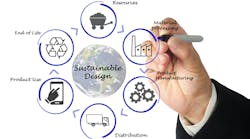Soaring through the sky as a pre-historic dragonfly, engaging in a full-body virtual basketball game, and reporting “live” from the White House – state-of-the-art technology is enabling highly interactive, immersive experiences for museum goers worldwide.
Whether it’s integrating gesture-recognition social software, creating 3D/4D experiences, or constantly updating exhibits with real-time information, museums are evolving into new entities.
“We’re seeing phenomenal change in technology that allows us to create and interact with a virtual world, as well as new ways to provide connectivity to the real world. Museums are rapidly transforming from isolated destinations for visitors into centers within interactive and distributed learning networks,” says David Greenbaum, FAIA, LEED AP, vice president, national cultural practice leader, SmithGroup, Washington, D.C.
Gesture Recognition
Take the Powerhouse Museum in Sydney, Australia, for example. Tapping into a 3D gestural interface system developed by GestureTek, children use their hands and feet to interact with dynamic video while engaging in fitness-related activities, such as playing in a virtual pumpkin patch or catching virtual butterflies.
Similarly, at the Milton J. Rubenstein Museum of Science & Technology in Syracuse, NY, the GestureXtreme immersive basketball simulation game has gone a step beyond Wii; the system tracks full-body movement without a remote control. Children and adults see themselves in real-time as they play on a digital basketball court and experience how their muscular and skeletal systems work.
“I’d say that gesture recognition is one of the most popular things right now,” observes Tom Hennes, an experience museum designer and principal with Thinc Design, New York City. “People enjoy the intuitive quality of this interface; they engage with it very readily,”
Another fascinating GestureXtreme application is at the Gondwana-Das Praehistorium in Schiffweiler, Germany, where players flap their arms, lean, and crouch to simulate a flying dinosaur that’s hunting for food and defending against predators.
“This form of interaction is educational yet highly entertaining,” explains Vincent John Vincent, president, GestureTek, Sunnyvale, CA. “We’ve found that visitors retain what they’ve learned much better and are more inclined to return for a second visit when they’ve experienced intense interaction with motion- and gesture-driven exhibits.”
A New Dimension
Another high-tech trend is 3D and 4D theaters, as museums are transporting technologies developed by the attraction industry into their own environments to make history come alive, says Greenbaum.
At the Newseum in Washington, D.C., a high-tech theater combines 3D video, motion-based seats, lighting, air and water spritzers, leg ticklers, and bottom kickers to accent the stories of famous news reporters in history, says Dan Laspa, project manager, Electrosonic, Burbank, CA, whose AV company specified Christie digital cinema projectors and a Stewart curved screen for the 4D experience.
In Denver, The Wildlife Experience interactive museum is set to debut a unique 3D walk-through exhibit created by Digital Revolution Studies and Real D (both known for their work on Avatar).
According to Jessy Clark, the museum’s director of programs, “We have six beautiful 3D monitors and spent many hours walking through the exhibit, selecting locations that wouldn’t be invasive to the visitor experience” as visitors stroll along wearing 3D glasses and viewing original footage of wildlife scenes. “The cameras are visible yet tucked away in areas where we felt we could use a ‘wow’ factor.”
Another striking exhibit in the Globeology section of the museum is called Science On a Sphere, designed by the National Oceanic and Atmospheric Administration (NOAA). In this exhibit, constantly updated satellite images that portray environmental information, such as weather maps and sea turtle migration, are seamlessly projected onto a 6-foot globe. The combined effect of the four Sony projectors working together is a slowly rotating, 3D global image.
“By using Science On a Sphere to display NOAA’s data, we’re able to engage audiences of all ages and build public understanding of scientific, technological, and environmental topics,” explains Beth Russell, a scientific communications and data specialist with NOAA in Boulder, CO.
Fully embracing state-of-the-art technology to educate visitors about wildlife, the museum also features animatronics and touchscreen kiosks. “By interacting with animatronic ‘people,’ visitors ‘ask’ them questions by utilizing touchscreen technology,” explains Clark.
At the same time, creators of The Wildlife Experience put energy into integrating the technology with an eye on overall design. “By creating appealing kiosks for the touchscreens that blend into the exhibit, the screens are visible, but not awkward to visitors. The screens are small enough that, if the visitor chooses to read the traditional museum panels instead of the touchscreens, they don’t interfere with the look of each exhibit space,” adds Clark.
Emphasizing the importance of integrating technology in a careful, calculated manner, Hennes points out that “new technologies, when well-utilized, can broaden the palette of experience and enrich the power of that experience.” However, he says, when used superfluously, they’re distractions.
With these design guidelines in mind, the Newseum strategically selected various projector systems and LED signage to effectively immerse museums patrons into a multi-visual news environment. For instance, a large LED wall streams news feeds; projected video images highlight artifacts in the News History Gallery.
“The vision of the designer was to have the visitor surrounded by the flow of information, just as they would be in a real-life financial facility like Wall Street,” explains Newseum Vice President/Technology Jim Updike.
Another popular Newseum feature is the “Be a TV Reporter” interactive exhibit. Patrons deliver a news report from a teleprompter with a geographic location superimposed onto the background of the recorded footage.
Staying on Top of the Curve
Experts are emphasizing the importance of embracing and integrating state-of-the-art, interactive technology.
“Because technology has so changed the way people interact with information, media, and each other, museums fear being left behind if they don’t seek to adapt to current trends,” notes Hennes. “They also see this as a competitive necessity; competing for leisure time with many other types of venues, they have to avail themselves of every opportunity to support visitorship and interest."
Similarly, Clark predicts, “As we move into the future and the world of high-tech everything, it’s important that museums stay on top of the technology to provide their visitors with a meaningful, engaging experience. It’s definitely the wave of the future.”
Along with this charge is striking a balance between telling stories with artifacts while using technology to enhance that learning experience. “While advanced technology for AV media and computer interactive techniques are compelling, they have a limited shelf life as the technology ages and wears down,” observes Greenbaum. “In addition, the cost of new and/or replacement technologies can be staggering, so it will always remain important to create a balance between [between] low- and high-tech to make emotional and intellectual connections with visitors.”
The High-Tech Transformation
Experts agree that the high-tech museum revolution will continue; Hennes predicts rapid growth in this arena in the next 2 to 5 years. In particular, the New York designer sees a greater adoption of real-time simulation technology with sophisticated 2D and 3D displays and interfaces, and video projectors changing from heat-intensive light sources to LEDs, which will miniaturize projectors, opening up many new applications to video-projected environments.
Vincent sees 3D tracking systems gaining traction as the cost of 3D depth-sensing cameras come down. With GestureTek and Hitachi set to release the first remote gesture-controlled television this year, and the next generation of gaming technology effectively eliminating hand-held controls, we’re bound to see more museum applications.
Currently, there is much demand for surface technologies, like interactive walls, floors, and tables, and free-floating screens, as well as multi-touch technology that enables museum visitors to virtually manipulate and control on-screen content with hand movements (just like Tom Cruise in Minority Report).
“Museums are competing with amusement parks and other attractions, so there’s never any shortage of interest in exciting, interactive technologies that will attract visitors, keep them at the museum longer, inspire them to make a return visit, and encourage them to tell their friends,” says Vincent. “We’ve built a business around incorporating advanced technologies into interactive museum exhibits; we expect to see demand continue to grow in the museum market.”
Similarly, Greenbaum concludes, “For museums to prosper, they must continually reinvent themselves to draw audiences and stay relevant. Technology is an essential tool to help make that happen.”
Barbara Horwitz-Bennett is a frequent contributor to building and construction publications (www.BHBennett.com).


